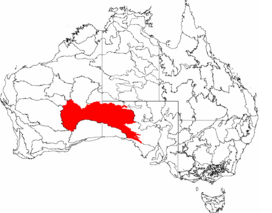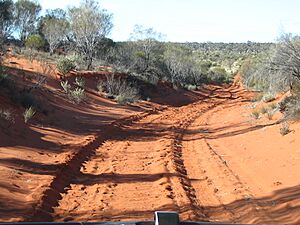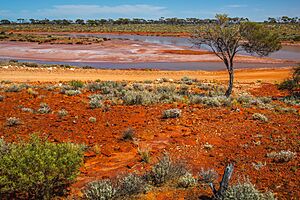Great Victoria Desert facts for kids
Quick facts for kids Great Victoria Desert |
|
|---|---|

|
|

Map of the IBRA regions, with the Great Victoria Desert in red
|
|
| Ecology | |
| Realm | Australasian |
| Biome | Deserts and xeric shrublands |
| Borders |
List
|
| Geography | |
| Area | 422,466 km2 (163,115 sq mi) |
| Country | Australia |
| States | South Australia and Western Australia |
| Conservation | |
| Conservation status | Relatively stable/intact |
| Protected | 129,367 km2 (31%) |
The Great Victoria Desert is a huge, mostly empty desert area in Western Australia and South Australia. It's a special kind of ecoregion, which means it's a large area with similar plants, animals, and climate. It's also known as an interim Australian bioregion.
Contents
Exploring the Great Victoria Desert
In 1875, a British-born Australian explorer named Ernest Giles was the first European to travel all the way across this desert. He decided to name it after the queen at that time, Queen Victoria.
Later, in 1891, another group led by David Lindsey crossed the desert from north to south. Between 1903 and 1908, Frank Hann explored the area, looking for gold. In the 1960s, Len Beadell also explored parts of this vast desert.
Where is the Great Victoria Desert?
The Great Victoria Desert is the largest desert in Australia. It stretches for over 700 kilometers (about 435 miles) from west to east. It covers a huge area of 348,750 square kilometers (about 134,650 square miles). This desert reaches from the Eastern Goldfields in Western Australia to the Gawler Ranges in South Australia.
The desert has many small sandhills and flat grassland areas. You can also find areas covered with tightly packed pebbles, which are called desert pavement or gibber plains. There are also many salt lakes.
Climate and Weather
The Great Victoria Desert gets very little rain, usually between 200 to 250 millimeters (8 to 10 inches) per year. The rainfall is also very unpredictable. Thunderstorms are quite common, with about 15 to 20 storms happening each year.
In summer, daytime temperatures are very hot, ranging from 32 to 40 degrees Celsius (90 to 104 degrees Fahrenheit). In winter, it's cooler, with temperatures between 18 to 23 degrees Celsius (64 to 73 degrees Fahrenheit).
The Great Victoria Desert is recognized as a special ecoregion by the World Wildlife Fund. It is also an official region in Australia's system for dividing up natural areas.
People of the Desert
Most of the people who live in the Great Victoria Desert are Indigenous Australians. These include different groups like the Kogara, the Mirning, and the Pitjantjatjara. The number of Aboriginal people living in this area has been growing.
Young Indigenous adults from this region take part in programs like Wilurarra Creative. These programs help them keep their culture strong and develop new skills.
Even though the desert is isolated, there are some very rough roads that cross it. These include the Connie Sue Highway and the Anne Beadell Highway. People have also done some mining in the desert. In the past, there were also nuclear weapons testing activities here.
Plants of the Great Victoria Desert
Only the toughest plants can survive in this harsh desert environment. In the areas between the sand ridges, you can find wooded steppes. These are open woodlands with trees like Eucalyptus gongylocarpa and Eucalyptus youngiana. There are also Acacia aneura shrubs, which are also known as mulga.
Underneath these trees and shrubs, you'll find tough spinifex grasses, especially Triodia basedowii. These grasses are very good at surviving in dry conditions.
Animals of the Great Victoria Desert
The animals living here have learned to cope with the tough desert conditions. You won't find many large birds or mammals, but some, like emus and red kangaroos, do live here.
The desert is home to many types of lizards. These include the vulnerable great desert skink (Egernia kintorei) and the Central Ranges taipan, a snake discovered in 2007.
There are also several small marsupials. These include the endangered sandhill dunnart (Sminthopsis psammophila) and the crest-tailed mulgara (Dasycercus cristicauda).
Animal Survival Strategies
Many desert animals survive by burrowing into the sand. This helps them escape the heat. Examples include the southern marsupial mole (Notoryctes typhlops) and the water-holding frog.
Birds found here include the chestnut-breasted whiteface (Aphelocephala pectoralis), which lives on the eastern side of the desert. The malleefowl can be found in Mamungari Conservation Park.
Predators in the desert include the dingo, as the desert is north of the Dingo Fence. There are also two large monitor lizards: the perentie (Varanus giganteus) and the sand goanna (Varanus gouldii).
Protecting the Desert

Because this area has not been used much for farming, many of its natural habitats are still in good condition. About 31% of the Great Victoria Desert is protected. This means these areas are set aside to keep them safe.
One important protected area is Mamungari Conservation Park in South Australia. This park is a large area of untouched desert wilderness. It is very important culturally to Aboriginal people and is one of Australia's 14 World Biosphere Reserves.
Other large protected areas include:
- Antara-Sandy Bore Indigenous Protected Area
- Apara-Makiri-Punti Indigenous Protected Area
- De La Poer Range Nature Reserve
- Gawler Ranges National Park
- Gawler Ranges Conservation Park
- Great Victoria Desert Nature Reserve
- Kalka-Pipalyatjara Indigenous Protected Area
- Lake Gairdner National Park
- Mamungari Conservation Park
- Mount Willoughby Indigenous Protected Area
- Neale Junction Nature Reserve
- Ngaanyatjarra Indigenous Protected Area
- Nullarbor Regional Reserve
- Plumridge Lakes Nature Reserve
- Pureba Conservation Park
- Queen Victoria Spring Nature Reserve
- Tallaringa Conservation Park
- Walalkara Indigenous Protected Area
- Watarru Indigenous Protected Area
- Yellabinna Regional Reserve
- Yellabinna Wilderness Protection Area
- Yeo Lake Nature Reserve
- Yumbarra Conservation Park
In the 1950s and early 1960s, the United Kingdom carried out nuclear tests at places like Maralinga and Emu Field within the desert. These tests left some areas with radioactive materials, which means they are not safe for people to live in.
See also
 In Spanish: Gran Desierto de Victoria para niños
In Spanish: Gran Desierto de Victoria para niños
- Deserts of Australia
- List of deserts by area
- Tallaringa Conservation Park




